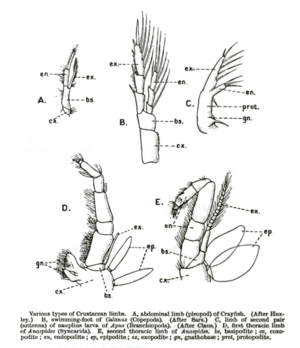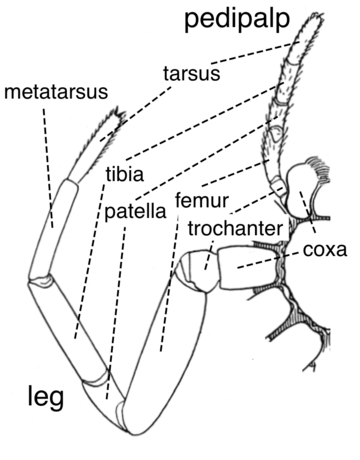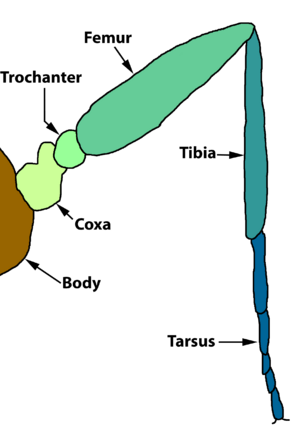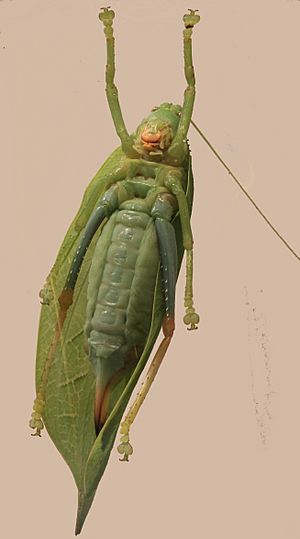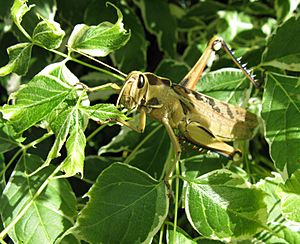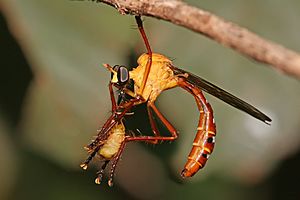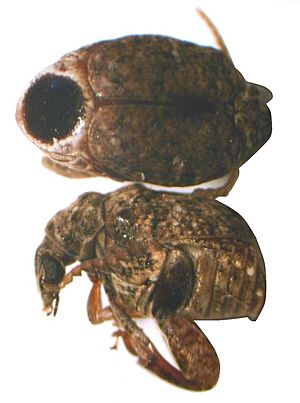Arthropod leg facts for kids
Arthropod legs are jointed body parts that help these animals move around. An arthropod is an animal with an exoskeleton, a segmented body, and jointed legs. Insects, spiders, and crabs are all arthropods. Each leg is made of several smaller parts, called podomeres. These parts have Latin names, which can be a bit tricky. Some common podomere names include coxa (like a hip), femur, tibia, and tarsus.
Scientists sometimes find it hard to compare leg parts between different arthropod groups. This is because legs might have changed a lot over time. Some think the first arthropod legs had many segments, but modern arthropods have fewer. It's also possible that different groups developed similar leg parts on their own.
Contents
Biramous and Uniramous Legs
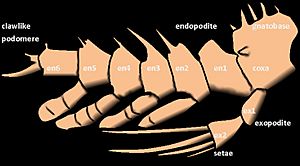
Arthropod legs can be either biramous or uniramous.
- A uniramous leg is a single, unbranched limb. It has one series of segments connected end-to-end.
- A biramous leg branches into two parts. Each branch also has segments connected end-to-end.
In crustaceans, the outer branch of a biramous leg is called the exopod. The inner branch is called the endopod. The exopod has its own muscles. Sometimes, the exopod is missing in some crustaceans, like amphipods and isopods. Insects do not have exopods at all.
Insects and myriapods (like centipedes and millipedes) have uniramous legs. Most crustaceans have biramous legs, though their first antennae are uniramous.
Scientists once thought that all arthropods with uniramous legs were closely related. They grouped them into a category called Uniramia. However, it is now believed that many arthropod groups developed uniramous legs separately. This means they evolved from ancestors that had biramous legs. So, the group Uniramia is no longer used.
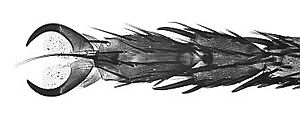
Chelicerata Legs
Arachnids, like spiders, have legs that are a bit different from insects. They have seven segments in total. These include the patella (between the femur and tibia) and the metatarsus (between the tibia and tarsus).
Scorpions also have seven leg segments, plus an extra "pre-tarsus" at the very end. The large claws of scorpions are not true legs. They are special body parts called pedipalps. Spiders also have pedipalps, which they use for catching prey and mating.
Horseshoe crabs have six leg segments. They do not have metatarsi or pretarsi.
Crustacean Legs
The legs of crustaceans originally have seven segments. These segments have different names than those in insects and arachnids. They are: coxa, basis, ischium, merus, carpus, propodus, and dactylus. In some crustaceans, certain leg segments might be fused together.
The claw of a lobster or crab is formed by the dactylus moving against an outgrowth of the propodus. Crustacean legs are also unique because they are biramous (two-branched). All other living arthropods have uniramous (single-branched) legs.
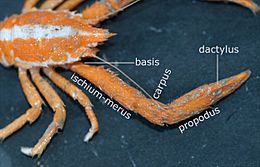
Myriapod Legs
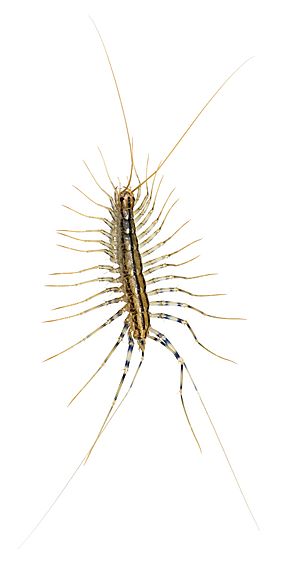
Myriapods, which include millipedes and centipedes, have seven-segmented walking legs. These segments are the coxa, trochanter, prefemur, femur, tibia, tarsus, and a tarsal claw.
Myriapod legs can be modified for different uses:
- In all centipedes, the first pair of legs are changed into venomous fangs called forcipules.
- In most adult male millipedes, one or two pairs of walking legs are modified into gonopods. These are used to transfer sperm.
- Some male millipedes have their first leg pair reduced to tiny hooks. Others have them greatly enlarged.
Insect Legs
Insects and their relatives are called hexapods because they have six legs. All six legs are attached to the thorax, which is the middle part of their body. Each leg has five main parts. From the body outwards, these are the coxa, trochanter, femur, tibia, and tarsus. Each of these is usually a single segment, except for the tarsus. The tarsus can have three to seven smaller segments, called tarsomeres.
Basic Parts of Insect Legs
A typical insect leg, like that of a housefly or cockroach, has the following parts in order:
- Coxa: This is the first part of the leg, closest to the body. It connects the leg to the insect's main body (exoskeleton).
- Trochanter: This small segment connects the coxa to the femur. It is often fixed tightly to the femur.
- Femur: In most insects, the femur is the largest part of the leg. It is very noticeable in insects that jump, like grasshoppers. The femur contains strong muscles needed for leaping.
- Tibia: The tibia is usually thinner than the femur but often just as long or longer. It often has one or more spurs near its end. Some insects use a special spur on their front tibia to clean their antennae.
- Tarsus: The tarsus is the foot-like part of the leg. It is often divided into several smaller segments called tarsomeres. The number of tarsomeres can vary between different insect groups.
- Pretarsus: This is the very last segment of the leg. Most insects have a pair of claws, called ungues, on their pretarsus. Between the claws, there might be sticky pads or bristles. These help insects climb smooth or steep surfaces. They work by creating strong surface forces.
How Insect Legs Are Used
The typical insect leg is designed for running. Cockroaches are a good example of insects with running legs. However, many insects have special legs adapted for different tasks:
- Digging: The front legs of mole crickets and some dung beetles are shaped for burrowing in the ground.
- Catching Prey: The front legs of mantises and mantisflies are adapted to grab and hold prey.
- Reduced Legs: Some butterflies, like many Nymphalidae, have very small front legs. They only use two pairs of legs for walking.
- Jumping: In most Orthoptera (like grasshoppers), the hind legs are made for jumping. They have very strong femora with powerful muscles. Flea beetles also have strong hind femora that let them leap far.
- Climbing out of Seeds: Some beetles, like certain Bruchinae, have swollen hind legs. They use these to force their way out of hard seeds where they grew up.
- Catching Prey in Flight: The legs of Odonata (dragonflies and damselflies) are good for catching prey while flying. They are not very good for walking.
- Swimming: Most adult aquatic insects use specially adapted legs for swimming. Many young insects, however, swim by wiggling or other methods.
Images for kids
-
A webspinner, Embia major, showing its front leg with an enlarged tarsomere. This part contains the silk-spinning organs.
See also
 In Spanish: Pata (artrópodos) para niños
In Spanish: Pata (artrópodos) para niños


